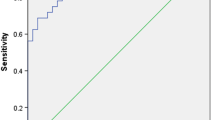Abstract
Background
Urinary NGAL (neutrophil gelatinase-associated lipocalin) levels have been shown to predict renal damage in various medical conditions. The present study was conducted to study the role of urinary NGAL levels in children with bladder exstrophy–epispadias complex post single-stage total reconstruction (SSTR) as markers of early renal function reduction.
Methods
Urine samples were collected from children with bladder exstrophy before SSTR (Group A, n = 11), 5 years post SSTR (Group B, n = 40) and controls (Group C, n = 41) and stored at − 20 °C. NGAL levels were estimated using double antibody sandwich ELISA.
Results
Mean NGAL levels in Groups A, B and C were 1.39, 34.24 and 2.58 ng/ml, respectively. Mean NGAL levels among Group B subjects with glomerular filtration rate (GFR) ≥ 80 ml/min/1.73 m2 body surface area (BSA) was 29.8 ng/ml, while it was 31.74 ng/ml in those with GFR < 80 ml/min. Urine samples were also evaluated 6 months post SSTR. Mean NGAL at 6 months was 6.76 ng/ml, while at 12 months it was 30.3 ng/ml, remaining > 30 ng/ml at 18 and 24 months. Dimercaptosuccinic acid (DMSA) scans did not show any scarring, and GFR on diethylenetriamine pentaacetate (DTPA) scans remained stable.
Conclusions
Increasing levels of urinary NGAL following bladder-exstrophy and epispadias complex repair suggest that NGAL detects the earliest signs of renal damage even before any deterioration is observed in DMSA and/or DTPA-GFR scans. Further studies with an adequate sample size and periodic measurement of NGAL need to be performed before any definitive conclusion can be drawn.
Graphical Abstract




Similar content being viewed by others
Data availability
Data that support this study are available from the corresponding author upon reasonable request.
References
Gearhart JP, Mathews R, Taylor S et al (1998) Combined bladder closure and epispadias repair in the reconstruction of bladder exstrophy. J Urol 160:1182–1185. https://doi.org/10.1097/00005392-199809020-00062
Gearhart JP, Jeffs RD (2003) Exstrophy of the bladder, epispadias and other bladder anomalies. In: Walsh PC, Retik AB, Stamey TA, Vaughn ED (eds) Campbell’s urology. W.B. Saunders, Philadelphia, pp 1772–1812
Ellison JS, Ahn J, Shnorhavorian M, Grady R, Merguerian PA (2017) Long-term fate of the upper tracts following complete primary repair of bladder exstrophy. J Pediatr Urol 13:394.e1-394.e6. https://doi.org/10.1016/j.jpurol.2017.03.036
Gargollo PC, Borer JG, Diamond DA et al (2008) Prospective followup in patients after complete primary repair of bladder exstrophy. J Urol 180:1665–1670. https://doi.org/10.1016/j.juro.2008.05.076
Cruz DN, de Geus HR, Bagshaw SM (2011) Biomarker strategies to predict need for renal replacement therapy in acute kidney injury. Semin Dial 24:124–131. https://doi.org/10.1111/j.1525-139X.2011.00830.x
Wasung ME, Chawla LS, Madero M (2015) Biomarkers of renal function, which and when? Clin Chim Acta 438:350–357. https://doi.org/10.1016/j.cca.2014.08.039
Bolignano D, Donato V, Coppolino G et al (2008) Neutrophil gelatinase-associated lipocalin (NGAL) as a marker of kidney damage. Am J Kidney Dis 52:595–605. https://doi.org/10.1053/j.ajkd.2008.01.020
Mori K, Nakao K (2007) Neutrophil gelatinase-associated lipocalin as the real-time indicator of active kidney damage. Kidney Int 71:967–970. https://doi.org/10.1038/sj.ki.5002165
Mitsnefes MM, Kathman TS, Mishra J et al (2007) Serum neutrophil gelatinase-associated lipocalin as a marker of renal function in children with chronic kidney disease. Pediatr Nephrol 22:101–108. https://doi.org/10.1007/s00467-006-0244-x
Smith ER, Lee D, Cai MM et al (2013) Urinary neutrophil gelatinase-associated lipocalin may aid prediction of renal decline in patients with non-proteinuric Stages 3 and 4 chronic kidney disease (CKD). Nephrol Dial Transplant 28:1569–1579. https://doi.org/10.1093/ndt/gfs586
Bolignano D, Coppolino G, Campo S et al (2008) Urinary neutrophil gelatinase-associated lipocalin (NGAL) is associated with severity of renal disease in proteinuric patients. Nephrol Dial Transplant 23:414–416. https://doi.org/10.1093/ndt/gfm541
Ding H, He Y, Li K et al (2007) Urinary neutrophil gelatinase-associated lipocalin (NGAL) is an early biomarker for renal tubulointerstitial injury in IgA nephropathy. Clin Immunol 123:227–234. https://doi.org/10.1016/j.clim.2007.01.010
Bolignano D, Coppolino G, Campo S et al (2007) Neutrophil gelatinase-associated lipocalin in patients with autosomal-dominant polycystic kidney disease. Am J Nephrol 27:373–378. https://doi.org/10.1159/000103912
Wasilewska A, Taranta-Janusz K, Dębek W et al (2011) KIM-1 and NGAL: new markers of obstructive nephropathy. Pediatr Nephrol 26:579–586. https://doi.org/10.1007/s00467-011-1773-5
Acknowledgments
The contribution of all patients who participated in the study is acknowledged. The funds received from the Indian Council of Medical Research were used to purchase the Urinary Neutrophil gelatinase-associated lipocalin ELISA kits for enzyme estimation.
Funding
This study was funded by the Indian Council of Medical Research (Grant number: I-632) as part of a research project.
Author information
Authors and Affiliations
Corresponding author
Ethics declarations
Conflict of interest
Author (Minu Bajpai) has received research grants from Indian Council of Medical Research (Grant number: I-632).
Ethical approval
All procedures performed in the study were in accordance with the ethical standards of the institutional ethics committee.
Informed consent
Informed consent was obtained from the parents or guardians of all individual participants included in the study.
Additional information
Publisher's Note
Springer Nature remains neutral with regard to jurisdictional claims in published maps and institutional affiliations.
Rights and permissions
Springer Nature or its licensor (e.g. a society or other partner) holds exclusive rights to this article under a publishing agreement with the author(s) or other rightsholder(s); author self-archiving of the accepted manuscript version of this article is solely governed by the terms of such publishing agreement and applicable law.
About this article
Cite this article
Gupta, A., Bajpai, M., Anand, S. et al. Preoperative and postoperative urinary NGAL levels in children with bladder exstrophy. J Nephrol 36, 1409–1414 (2023). https://doi.org/10.1007/s40620-022-01548-x
Received:
Accepted:
Published:
Issue Date:
DOI: https://doi.org/10.1007/s40620-022-01548-x




